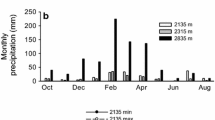Summary
This study examined the water relations and growth responses of Uniola paniculata (sea oats) to (1) three watering regimes and (2) four controlled water-table depths. Uniola paniculata is frequently the dominant foredune grass along much of the southeastern Atlantic and Gulf coasts of the United States, but its distribution is limited in Louisiana. Throughout most of its range, U. paniculata tends to dominate and be well adapted to the most exposed areas of the dune where soil moisture is low. Dune elevations in Louisiana, however, rarely exceed 2 m, and as a result the depth to the water table is generally shallow. We hypothesized that if U. paniculata grows very near the water-table, as it may in Louisiana, it will display signs of water-logging stress. This study demonstrated that excessive soil moisture resulting from inundation or shallow water-table depth has a greater negative effect on plant growth than do low soil moisture conditions. Uniola paniculata's initial response to either drought or inundation was a reduction of leaf (stomatal) conductance and a concomitant decrease in leaf elongation. However, plants could recover from drought-induced leaf xylem pressures of less than-3.3 MPa, but prolonged inundation killed the plants. Waterlogging stress (manifested in significantly reduced leaf stomatal conductances and reduced biomass production) was observed in plants grown at 0.3 m above the water table. This stress was relieved, however, at an elevation of 0.9 m above the water table. As the elevation was increased from 0.9 to 2.7 m, there were no signs of drought stress nor a stimulation in growth due to lower soil moisture. We concluded that although U. paniculata's moisture-conserving traits adapt it well to the dune environment, this species can grow very well at an elevation of only 0.9 m above the water table. Field measurements of water-table depth in three Louisiana populations averaged about 1.3 m. Therefore, the observed limited distribution of U. paniculata along the Louisiana coast apparently cannot be explained by water-logging stress induced by the low dune elevations and the corresponding shallow water-table depth.
Similar content being viewed by others
References
Au Shu-Fun (1970) Vegetation and ecological processes on Shackleford Banks, North Carolina. Ph.D. disseration, Duke University
Brown WV, Smith BN (1974) The Kranz syndrome in Uniola (Graminae). Bull Torrey Bot Club 101:117–120
Coultas CL, Breitenbeck GA, Kruczynski WL, Subrahmanyam CB (1978) Vegetative stabilization of dredge spoil in North Florida. Soil Water Conserv 33(4):183–185
Dahl BE, Woodard DW (1977) Construction of Texas coastal foredunes with sea oats (Uniola Paniculata) and bitter panicum (Panicum amarum). Int J Biom 21:267–275
De Jong TM (1979) Water and salinity relations of Californian beach species. J Ecol 67:647–663
Hester MW (1985) Investigations of factors affecting the distribution and growth of Uniola paniculata (sea oats) along the Louisiana coast: status of natural populations, seed ecology, and plant responses to water availability. M.S. thesis, Louisiana State University
Hosier PE (1973) The effects of oceanic overwash on the vegetation of Core and Shackleford Banks, North Carolina. Ph.D. dissertation, Duke University
Hurd EA (1974) Phenotype and drought tolerance in wheat. Agr Metaorol 14:39–55
Kramer PJ (1963) Water stress and plant growth. Agr J 55:31–35
Mendelssohn IA, Hester MW (1985) Texaco USA coastal vegetation project, 1984 annual report. Laboratory for Wetland Soils and Sediments, Center for Wetland Resources, Louisiana State University, Baton Rouge
Mendelssohn IA, Jordan JW, Talbot F, Starkovich CJ (1983) Dune building and vegetative stabilization in a sand deficient barrier island environment. Proc 3rd Symp on Coastal and Ocean Management, San Diego, CA
Mendelssohn IA, Penland S, Patrick WH Jr (eds) (1987) Barrier islands and beaches of the Mississippi River delta plain. Report submitted to the Louisiana Department of Natural Resources, Baton Rouge
Monteferrante FJ (1986) Water relations of sand dune and swale vegetation in Louisiana. Ph.D. dissertation, Louisiana State University, Baton Rouge
Monteferrante FJ, Mendelssohn IA, Hester MW (1982) Vegetative investigations for the management of barrier islands and beaches in Louisiana. In: Proc Coast Soc 8, pp 231–239
Oertel GF, Larson M (1976) Developmental sequences in Georgia coastal dunes and distribution of dune plants. Bull Georgia Acad Science 34:35–48
Olsson-Seffer P (1909) Hydrodynamic factors influencing plant life on sandy seashores. New Phytol 8:39–49
Oosting HJ (1954) Ecological processes and vegetation of the maritime strand in the southeastern United States. Bot Rev 20:226–262
Oosting HJ, Billings WD (1942) Factors affecting vegetational zonation on coastal dunes. Ecology 23:131–142
Pavlik BM (1980) Patterns of water potential and photosynthesis of desert and sand dune plants, Eureka Valley, California. Oecologia 46:147–154
Penland S, Boyd R (1985) Transgressive depositional environments of the Mississippi River delta plain. Guidebook Series No. 3. Louisiana Geological Survey, Baton Rouge, Louisiana p 233
SAS Institute, Inc. 1982. SAS User's Guide. SAS Institute, Inc., Cary, NC
Scholander PF, Hammel HT, Bradstreet ED, Hemmingsen EA (1965) Sap pressure in vascular plants. Science 148:339–346
Seneca ED (1972) Germination and seedling response of Atlantic and Gulf Coast populations of Uniola paniculata. Am J Bot 59:290–296
Steel RGD, Torrie JH (1980) Principles and procedures of statistics. McGraw-Hill, New York, p 481
Travis R (1977) The effects of aspect and exposure on the growth of dune grasses in Cape Hatteras National Seashore. Int J Biomet 21:217–226
Turner NC, Burch GJ (1983) The role of water in plants. In: Crop water relations. John Wiley and Sons, New York, pp 73–76
Wagner RH (1964) The ecology of Uniola paniculata L. in the dune strand habitat of North Carolina. Ecol Monogr 345:79–96
Woodhouse WW Jr, Hanes RE (1966) Dune stabilization and vegetation on the Outer Banks of North Carolina. Dept. of Soil Science, North Carolina State Univ. at Raleigh. Soil Sci Ser 8
Woodhouse WW Jr, Seneca ED, Cooper AW (1968) Use of sea oats for dune stabilization in the southeast. Shore and Beach, October, pp 25–21
Author information
Authors and Affiliations
Rights and permissions
About this article
Cite this article
Hester, M.W., Mendelssohn, I.A. Water relations and growth responses of Uniola paniculata (sea oats) to soil moisture and water-table depth. Oecologia 78, 289–296 (1989). https://doi.org/10.1007/BF00379100
Received:
Issue Date:
DOI: https://doi.org/10.1007/BF00379100




